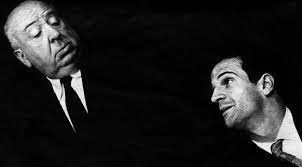There’s a bomb under your chair, and whether you know about it or not affects surprise and suspense.
When it comes to suspense, I think we should listen to the master. If you read No Film School often, you know I am a massive Alfred Hitchcock fan. And I have been advocating for everyone to read Hitchcock/Truffaut, a book that compiles the conversations these two incredible directors had about film and form.
And you can listen to all 25 tapes of them chatting for free online as well.
One snippet I go back to with every screenplay I write is the difference between the idea of surprises in storytelling and suspense.
Alfred Hitchcock explains to Truffaut his point of view when it comes to these two very different words and what they mean to cinema.
Hitchcock says:
“There is a distinct difference between ‘suspense’ and ‘surprise,’ and yet many pictures continually confuse the two. I’ll explain what I mean. We are now having a very innocent little chat. Let’s suppose that there is a bomb underneath this table between us. Nothing happens, and then all of a sudden, ‘Boom!’ There is an explosion. The public is surprised, but prior to this surprise, it has seen an absolutely ordinary scene, of no special consequence. Now, let us take a suspense situation. The bomb is underneath the table and the public knows it, probably because they have seen the anarchists place it there. The public is aware the bomb is going to explode at one o’clock and there is a clock in the decor. The public can see that it is a quarter to one. In these conditions, the same innocuous conversation becomes fascinating because the public is participating in the scene. The audience is longing to warn the characters on the screen: ‘You shouldn’t be talking about such trivial matters. There is a bomb beneath you and it is about to explode!’ In the first case, we have given the public fifteen seconds of surprise at the moment of the explosion. In the second we have provided them with fifteen minutes of suspense. The conclusion is that whenever possible the public must be informed. Except when the surprise is a twist, that is, when the unexpected ending is, in itself, the highlight of the story.”
This is such a fun answer, I have to nerd out about it for a second and get analytical.
Hitchcock distinguishes between suspense and surprise by presenting two contrasting scenarios. In the first scenario, there is a bomb under the table, but the audience is unaware of it until it suddenly explodes. This creates a momentary surprise for the viewers, as they had no prior knowledge or anticipation of the event. However, since the preceding scene was unremarkable and ordinary, the surprise lacks a lasting impact.
It’s just a gimmick, and as storytellers, we want something more than just a gimmick.
We want to hook the audience and play with them.
Hitchcock describes a suspenseful situation where the audience is aware of the bomb under the table. The viewers have been informed about the bomb’s presence and its impending explosion at a specific time. They are also aware of the ticking clock, which adds to the tension.
And a ticking clock is a writer and director’s best friend. It keeps the audience on the edge of their seat.
They are freaking out.

In this scenario, the audience becomes actively engaged in the scene, feeling a sense of anticipation and participating mentally by wanting to warn the characters of their impending danger. This creates a heightened level of suspense that lasts.
However, Hitchcock notes an exception to this principle. There’s ALWAYS an exception.
He states that surprise can be effective when it serves as a twist, a sudden unexpected ending that itself becomes the highlight of the story — in these cases, keeping the audience uninformed until the final reveal can create a powerful impact.
The surprise ending becomes the focal point and leaves a lasting impression on the viewers.
As you can see, these are all decisions that affect the outcome of the story and also the involvement of the audience.
Let me know what you think in the comments.













